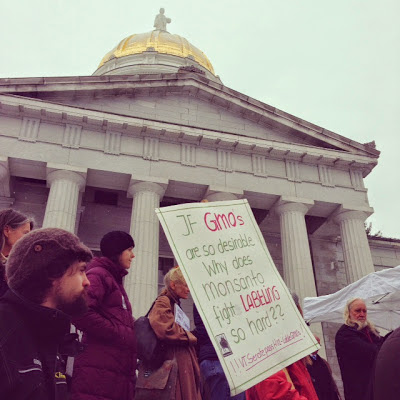 We’re thrilled to have a guest blog by Will Allen and Kate Duesterberg of Cedar Circle Farm in Vermont. Will and Kate were instrumental in the recent win for GMO labeling in Vermont. We asked Will and Kate to tell us how Vermonters came together to get it done.
We’re thrilled to have a guest blog by Will Allen and Kate Duesterberg of Cedar Circle Farm in Vermont. Will and Kate were instrumental in the recent win for GMO labeling in Vermont. We asked Will and Kate to tell us how Vermonters came together to get it done.
Public opinion polls across the country continually show overwhelming support for labeling foods that contain genetically modified organisms or GMOs. US citizens, increasingly aware of the fact that 90% of processed foods contain GMOs, want to emulate the 64 other countries around the world that label these products. The vehemence with which Vermonters showed their concerns regarding this issue initially surprised the legislators. But, over time, Vermonters convinced their elected representatives that knowing what was in their food, particularly something that was possibly harmful to the health of their families and had the potential to cause considerable environmental damage, was very important to them.
After a three-year populist effort to enact a GMO labeling bill, the Vermont House bill H-112 passed the senate by an overwhelming vote of 28-2, and when it returned to the House, that body voted 114-30 to send it to the Governor for his signature. On May 8, 2014, Governor Peter Shumlin signed the bill into law.
It is often difficult to get non-profit groups to work together amicably, but we felt that creating a coalition of NGOs to address the issue of GMO labeling would have the greatest chance of success. Several organizations agreed to work together to organize the legislative campaign. The Vermont Right-to-Know Coalition was made up of three non-profits, NOFA/VT (Northeast Organic Farming Association); Rural Vermont, and VPIRG (Vermont Public Interest Research Group) and one community-based farm, Cedar Circle Farm. The Vermont Law School’s Environmental and Natural Resources Law Clinic provided valuable advice (beginning in 2013) on the legalities of the language in the bill. Each group had its own grassroots constituency.
The coalition was aided by the fact that the anti-GMO battle had been going on in Vermont for many years, and activists, no matter what their affiliation, came out for this effort. Unlike previous GMO struggles in the state, this campaign was greatly enhanced by the extensive use of social media. Funding for the coalition was obtained from both state and national funders.
The current legislative battle started in 2012 with a bill introduced in the House Ag Committee. That year, grassroots outreach was conducted all over the state to educate people about what was in the bill and to convince folks to contact their legislators and the Governor. As a result, the most powerful force in moving the bill along were grassroots Vermonters who showed up at meetings, did their own outreach to businesses and other consumers, created school programs, wrote thousands of letters and e-mails to legislators, posted yard signs, and made countless phone calls to House and Senate members and the Governor. The coalition made outreach to the Vermont citizenry a priority—and they responded every time, often in the worst weather imaginable (the Vermont legislative session runs primarily through the winter months).
While the bill passed the Agriculture Committee in 2012, it was stalled and passed too late in the final session of the biennium to go any further. Significantly, however, the Agriculture committee called for a public hearing on the bill and more than 400 Vermonters showed up. Over one hundred people testified, all in favor of the bill. This unanimous outpouring of support for the bill greatly impacted the legislators and ultimately the Governor.
In 2013, the current bill (slightly different than the 2012 version) was introduced. The coalition organized with even more vigor by hosting seven regional teach-ins all around the state. Finally, after considerable delay by the Judiciary committee the bill arrived on the House floor for a vote. It was approved by a vote of 99-42. Unfortunately, because of the delays, the House passed the bill too late in the session to cross over to the Senate (Vermont’s legislative session is only four months long). So, the bill had to await consideration by the Senate until 2014. During the summer of 2013, VPIRG conducted a statewide canvas on GMO labeling. They collected 30,000 signatures on the petition to label GMO foods. This canvas added more grassroots volunteers to our already significant base.
In 2014 the Senate Agriculture committee took up the bill on the first day of work in January. After considerable testimony from experts and advocates on both sides, the Senate Agriculture and Judiciary committees called for a second public hearing. Again, the statehouse was packed with hundreds of Vermonters. Once more, every one of the more than 100 people who testified supported passage of the bill. At that point, the coalition began an advertising campaign to counteract anti-labeling ads by the Grocery Manufacturers Association in New Hampshire, our neighboring state. We were able to continue advertising effectively throughout the remainder of the campaign.
Following the hearing, the bill passed out of the Agriculture Committee by a 4-1 vote. The Judiciary Committee then took up the bill and ultimately passed it by a 5-0 vote. The bill then proceeded to the Appropriations Committee and passed out of that committee 7-0. Appropriation committee deliberations centered on the need to create a fund that could support the state’s legal efforts in the event of a suit by the GMO corporations and the Grocery Manufacturers Association. A provision for that fund was added to the bill. After those astounding victories, where three Senate committees supported the bill with just one no vote, it moved to the Senate floor where it passed 28-2. Many of the Senators said that the deciding factor in their “yes” vote was the pressure from their constituents. Some Senators testified that they had received more than 1500 constituent letters, phone calls, or e-mails.
The bill then returned to the House Agriculture and Judiciary Committees for consideration of the Senate revisions to the bill. After positive reviews by both committees, the entire house voted on the bill. That 114-30 vote exceeded the original House vote in 2013, which was 99-42. Finally, on May 8, 2014, Governor Peter Shumlin signed the bill. This is the first time that a GMO labeling bill in the US has been passed in the legislature and signed by the Governor, and does not have a trigger that depends on other states passing a similar bill before the law goes into effect.
As Jim Hightower says, there is a new populist fervor emerging all over this country. Vermont’s successful campaign to finally label GMO foods is just one example of that trend. All the supporters involved in the Vermont labeling campaign realized that because of their united struggle, “this time, democracy worked.” The people spoke, shouted, campaigned, educated, agitated… and the legislators and the Governor listened.
This populist victory took three years and was energized instead of intimidated by the threat of a lawsuit from the gene giants and the GMA. Vermonters don’t take kindly to bullying by multinational corporations or anyone else. Vermont is also not afraid to be first, despite its tiny size, as it showed in being the first state to ban slavery, the first to legalize civil unions, the first to vote in gay marriage, the first to pass a single payer health bill, and the first to require labeling for GMO foods. Let’s hope it spurs similar actions in many other states. Our food system is broken and we the people have to take back control and create a food system that is actually healthy for people and the planet.
Will Allen and Kate Duesterberg are farmers, rural community organizers, and occasional authors. They currently co-manage Cedar Circle Farm in East Thetford, Vermont. Their website is www.cedarcirclefarm.org


